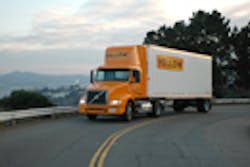More TL service, fewer terminals and miles yet faster transit times, a new labor agreement to create a more flexible workforce, and a greater focus on international freight – these are but a few ingredients in a new strategy YRC Worldwide is putting into play to reshape itself for handling massive changes occurring in the global and domestic freight markets.
“The complexity of global supply chains today is higher than ever and shippers are obsessed with not having any more inventory than they absolutely need – the focus in inventory reduction is higher than we’ve ever seen it,” said William Zollars, chairman, president & CEO of YRC Worldwide, a worldwide conglomerate of logistics and trucking firms such as Yellow Freight, Roadway, USF Glen Moore, New Penn, and others.
“What we’re seeing now is a focus on moving smaller shipments faster,” Zollars noted at a press conference held for transportation journalists in Washington, D.C. this week. “We’re also seeing a move to consolidate more LTL shipments into TL moves and keep as much inventory out of the supply chain as possible. There’s now simply more focus on transportation costs than ever.”
To adapt to this changing freight matrix, Zollars noted that YRC has been working on several fronts simultaneously to change its transit footprint in the U.S. and overseas.
Within its YRC National Transportation subsidiary – home to LTL carriers Yellow Freight and Roadway – some 20 million miles a year are being sliced from its routes, saving as much as $40 million annually, as it moves away from the traditional “hub and spoke” network design. That includes closing many terminals and decreasing the number of times freight must be handled in the network, noted Michael Smid, president & CEO of YRC North American.
“With our old ‘hub and spoke’ system, many times we had to go east first before we could go west to make a delivery,” he explained. “Now we’ve aligned ourselves closer to where freight originates and function more on a time-based structure. That gives us better freight velocity, a lot more consistency, and allows us to turn over our assets faster.”
As a result, YRC is able to compress service times, moving many two-day routes to next day, three day routes to two- or one-day service, and ship trans-continental freight in consistent four-day blocks as opposed to its previous three-to-five day window. At least 15% of the 150,000 shipments YRC moves every day domestically are going to see service improve by a day, said Smid.
This effort is also driving up use of TL service – both from its USF Glen Moore division and from outside providers – as YRC is starting to move away from heavy reliance on rail service for longer distance shipments. “Rail is becoming a real challenge because service has deteriorated so much – it’s more expensive and less reliable,” said Zollars. “The rails are full of coal and grain and are out of capacity. So we’re moving away from it to TL, which is more effective for cross-country moves.”
The company’s new labor deal with the Teamsters is also helping it become more flexible in day-to-day operations, he noted. It allows YRC to convert rail miles into TL miles, creates a “utility employee” designation for truck drivers, allowing them to work across all job classifications, from local to over-the-road. And it provides pension protection for five years, giving YRC consistency in its labor costs.
On the global front, YRC is wrapping up its $45 million purchase of Chinese LTL carrier Jiayu as it seeks to create more visibility for China-based supply chains as well as build business from within China itself.
“[Truck] transportation is very fragmented in China. It’s made up of mainly owner-operators,” said Zollars. “And many times when a shipment is picked up in China, it disappears into the supply chain – shippers don’t ‘see’ it until it reaches the port of Long Beach in the U.S. And if it’s the wrong thing, you’re dead.”
By owning a carrier in China, YRC not only hopes to make that part of the supply chain visible to international shippers, but to drum up business from Chinese customers as well. “We’re looking to access a whole new pool of customers, while bringing our global customers new services,” he noted. “It should result in a bigger piece of business.”
Despite these new efforts, Zollars stressed that major business challenges remain – the biggest one being the high cost of oil. “Our country is not built for $150 a barrel for oil,” he noted. “Though we are at a point of ‘economic stability’ as I put it, the real wild card is oil prices. They are a shock wave moving through the economy.”
He said the fuel surcharge at YRC’s trucking operations is 40% and the customer impact from that is multi-dimensional. “We’re trying to work with all our customers to reduce their cost in ways that won’t hurt us,” Zollars explained. “For example, instead of shipping every day of the week, move to shipments three days a week. Though 60% of our business is contractual, everyone is watching pricing – freight as well as fuel – very, very closely.”
Still, he said YRC remains on target for earnings in the second quarter this year. Its 30 to 40 cent per share profit projection from core operations in the second quarter remains unchanged, with the addition of a 34-cent per share boost from benefit plan equalization and a 9-cent per share cost due to higher accidents from its YRC National companies – all ending up with earnings per share predicted to be around 55 to 65 cents per share in the second quarter.
View more Fleet Owner management news and other commercial trucking-related articles.
About the Author
Sean Kilcarr
Editor in Chief
Sean Kilcarr is a former longtime FleetOwner senior editor who wrote for the publication from 2000 to 2018. He served as editor-in-chief from 2017 to 2018.
